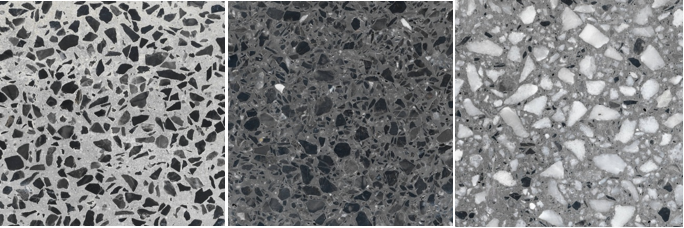In the previous article, we discussed tips on how to create sturdy yet elegant slabs. In this post, our experts in Terrazzo will enlighten you on the different materials used for slabs. Our aim is to educate home builders and commercial building owners on these materials and how you could leverage it for your projects.
Slabs differ based on texture, color and design finishes. It can also be classified through the different cuts and dimensions. Each of these are used to different types of environments and themes.
The Different Colors of Terrazzo Slabs
Terrazzo is made up of Portland cement, sand, marble and mineral chips. Each of these have different color pigments and textures. To learn more about different colors available, click here.
Black and Greys
Neutrals
Colors
Different Types of Terrazzo Slabs
* Terrazzo Tiles– typically, the size of these tiles ranges from 400mm x 400mm x 30mm to 600mm x 400mm x 35 mm. Lines and gaps are intended to be seen. This adds flavor and design to structures. Tiles can be easily maintained as well.


- Terrazzo Pavers– sizes are with the range of 400mm x 400mm to 400mm x 600mm. These are larger than tiles and have a thickness of 32 mm to 50 mm. These pavers are more durable and designed to withstand outdoor elements (water and climate).
These are typically non-slip and non-glossy. It is hermetically pressed to produce a stronger tile. Pavers are used for sidewalks, garden pavement, corporate building walkways and other outdoor establishments.

- Terrazzo In-Situ – this is the most premium material one can use from the Terrazzo line. Unlike tiles and pavers, In-situ is designed to be seamless. There are no gaps or lines between the tiles. This is very popular for indoor establishments like hotels, retail spaces, lobbies and other high-end residences.
In-situ has a larger dimension, each panel is around 1500 mm. Brass, rebonite or aluminum are used to support the bays preventing cracks caused by movements. It can have a non-glossy finish. Builders can also opt for a brushed finish. It will have an antiqued appearance.


Different Types of Finishes
Sealed Polished Finish – standard finish for commercial retail projects. The floor is ground on site and a protective shiny sealer applied to the floor. This sealer is maintained to ensure the floor always looks like the day it was handed over.
Machine Polished Finish – Floor is ground and machine polished on site with a penetrating sealer applied. This finish is suitable for low traffic areas.
Honed Anti-Slip Finish – Floor is ground on site to a honed finish. If non-slip finish is required, a non-slip additive is added to the manufacturing process that enables the floor to achieve at least an R10 finish that will not wear off. We do not recommend light colours to be chosen for this type of finish and epoxy grout is recommended.
Brushed Finish (In-Situ only) – Tiles are polished on site as per honed finished. The floor is then passed with brushes that give an antiqued appearance.




